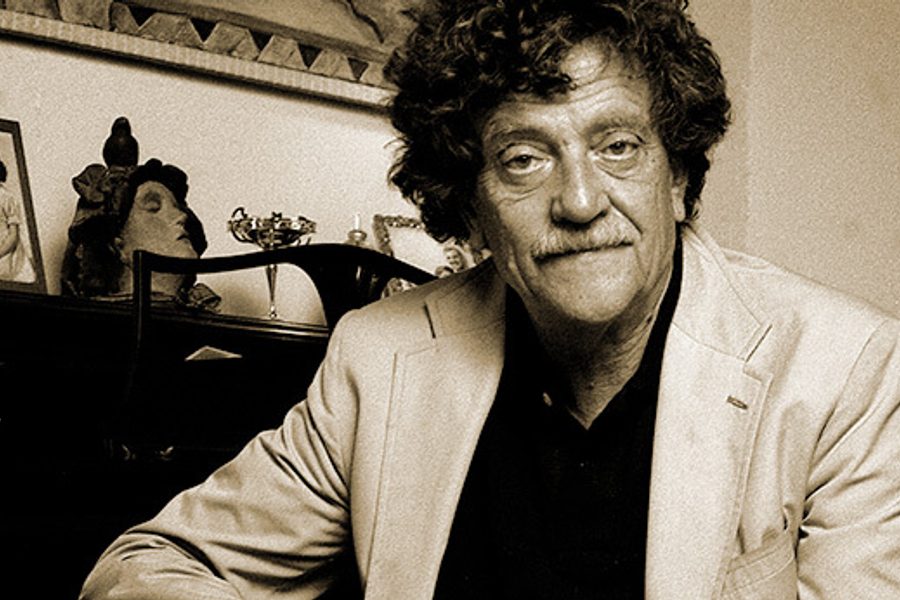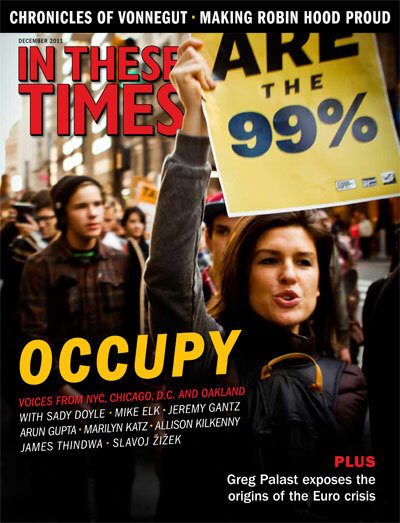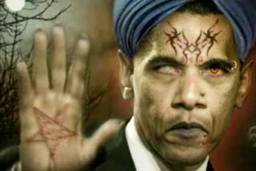Chronicles of Vonnegut
Two new books delve into the life and work of a man who couldn’t silence his political conscience.
Steve Weinberg

Caveat to those about to enter: If you have read some or all of Kurt Vonnegut’s novels, I trust this essay will resonate and perhaps enlighten. If you have not read Vonnegut’s fiction, perhaps I will lead you to it. When Vonnegut died nearly five years ago, American literature lost a giant. But readers of In These Times, for which Vonnegut wrote, understood something more than that obvious truism: Movements for political and socioeconomic reforms had lost a unique voice.
From an early age – he was born in 1922 – Vonnegut hoped to become an acclaimed novelist. He had no design, though, on becoming a cult hero among his readers, much less a respected voice opposing wars abroad (against Vietnam, for example) and at home (against the disadvantaged). It might seem outlandish to some to compare Vonnegut’s influence on political “liberals” to Ayn Rand’s influence on political “conservatives” – in part because Rand was a hack writer, and Vonnegut was not – but it does not feel outlandish to me.
In Unstuck in Time: A Journey Through Kurt Vonnegut’s Life and Novels (Seven Stories, November), Gregory Sumner documents, novel by novel, spanning 1952 (Player Piano) to 1997 (Timequake), how Vonnegut developed as both a writer and touchstone for reform. The reformist role began without intent, slowly building until Vonnegut accepted and sometimes even embraced it. Near the end of his life, even as he stopped publishing fiction meant to influence readers’ worldviews, Vonnegut spoke out publicly against powerful people who were subverting democratic government. He told anybody who would listen how George W. Bush had entered the White House by mounting “the sleaziest, low-comedy, Keystone Cops style coup d’état imaginable,” and that Dick Cheney and Donald Rumsfeld were “psychopathic personalities” who intended to disconnect “all the burglar alarms prescribed by the Constitution” as they expanded executive power.
A history professor at the University of Detroit Mercy, Sumner, like Vonnegut, grew up in Indianapolis. The initial general evaluation offered by Sumner about Vonnegut’s novels: “an impassioned and sometimes brokenhearted meditation on the American Dream.” Each novel took into account, implicitly or explicitly, the political movements within the America that Vonnegut, a World War II veteran, loved dearly and patriotically. In fact, the epigraph from Vonnegut chosen by Sumner to open the book states: “The function of an artist is to respond to his own time.”
Vonnegut’s responses obviously resonated with many Americans. They responded, Sumner says:
To Vonnegut’s unique voice with laughter, outrage and tears. We share his identification with those who struggle under the ethos of survival of the fittest, his concern about the price we pay for all of our machines and footloose mobility. … Vonnegut’s art is a record of the ways in which the experiment has gone terribly wrong, how language and mythology, dreams and stories, conceal injustices and great crimes.
At the literary level, Vonnegut’s novels are mixed – some of his plotting and stylistic devices seem sophomoric, while others are brilliant. Sumner recognizes these shortcomings within his mostly effusive praise.
And So It Goes: Kurt Vonnegut, A Life (Henry Holt, November), by Charles J. Shields, is a different sort of book than Unstuck in Time, which focuses on the novels. Like Sumner, Shields – who previously chronicled the life of Harper Lee – entered the project favorably disposed toward Vonnegut. When Shields approached Vonnegut in 2006 about cooperating with the first-ever biography, his admiration shone through: “I predict this – the importance of your work as a writer and social critic is about to receive renewed attention. … Your novels, filled with wit and anti-authoritarian jabs, will be part of the literature that guides and inspires the next forward-looking age.”
Vonnegut declined at first but eventually cooperated with Shields, granting the biographer access to himself and his letters during his final year. But after Vonnegut’s death in 2007, his widow Jill Krementz wouldn’t meet with Shields, and his son Mark Vonnegut, co-executor of the estate, refused the biographer permission to use Kurt’s 258 letters. (Shields uses information from the letters, but does not quote directly.)
Fortunately, Shields is such a determined and skilled biographer that the book turned out well. It’s no hagiography, revealing Vonnegut as often self-centered, sometimes downright mean and seemingly forgetful about his privileged life growing up. Shields explains how Vonnegut treated his first wife poorly after more than two decades of marriage. He could come across as an uninterested and sometimes insensitive father. He often drank to excess. Vonnegut sometimes demonstrated meanness to reviewers and other writers who did not seem to adequately appreciate his accomplishments. However, And So It Goes is also rich with examples of Vonnegut’s generosity, such as helping rear four children whose parents (Vonnegut’s sister and brother-in-law) both died young.
I was first drawn to Vonnegut because of his most famous novel, Slaughterhouse-Five, published in 1969 when I was a college senior and seeking conscientious objector status to avoid the murderous Vietnam War by performing two years of alternate civilian service. The book can easily be interpreted as antiwar, and it strengthened my opposition to America’s Asian fiasco. Only gradually, as I found my way to Vonnegut’s earlier novels and kept up with his later work, did I realize what Sumner summarizes so well:
Vonnegut was a critic of the American experiment, an outsider of sorts, a man of the Left, broadly speaking. He loved the socialism of his German American forebears and the labor militancy of fellow Hoosiers Eugene Debs and Powers Hapgood. … Vonnegut understood in his bones the wages of the Ponzi-schemed, predatory capitalism that had wrecked so many lives in the years after 1929, including those of his mother and father. He was freethinking and pacifist by inclination, inspired by the … antimilitarism widespread in the heartland as Europe lurched toward another war in the late 1930s. He found knee-jerk nationalism in any form repellent. … He was a communitarian in politics and approved of many of the aspects of the sixties’ youth revolt to which he was an elder statesman – civil rights, women’s equality, environmentalism.
As Vonnegut’s legacy becomes gradually settled, most important is the understanding that a high-profile novelist can use his influence to make the world a better place. In that regard, Vonnegut scores high.








